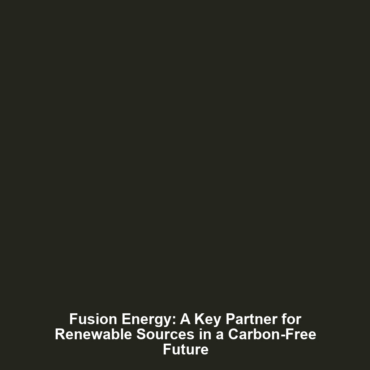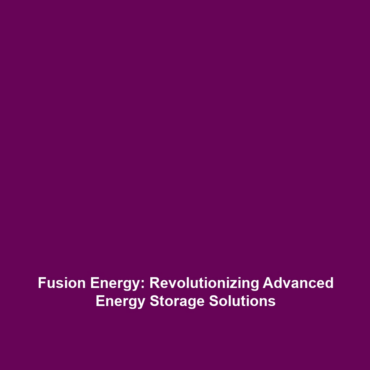Fusion and Renewables: Building a Carbon-Free Energy Future
As the world grapples with climate change, the need for a sustainable energy future has never been more pressing. Fusion energy, a revolutionary power source, has the potential to work in tandem with renewable energy sources such as wind and solar. This synergy could pave the way for a diversified, carbon-free energy grid that meets global energy demands sustainably. Understanding the intersection between fusion energy and renewables is crucial as we transition to a cleaner energy landscape.
Key Concepts of Fusion Energy and Renewables
To grasp the significance of fusion energy alongside renewables, it’s essential to explore the following principles:
- Fusion Basics: Fusion involves combining atomic nuclei to release energy—a process that powers the sun and has the potential to provide nearly limitless energy without carbon emissions.
- Renewables Overview: Renewable energy sources such as wind, solar, and hydroelectric power harness natural processes to produce energy and are critical to reducing fossil fuel dependence.
- Complementary Roles: Fusion energy can produce a stable, base-load power generation that complements the intermittent nature of solar and wind energy, ensuring a reliable energy supply.
Applications and Real-World Uses
Fusion energy’s potential applications alongside renewables are significant:
- Integrated Energy Systems: By combining fusion reactors with wind and solar farms, energy systems could become more resilient and efficient, balancing supply and demand effectively.
- Hydrogen Production: Fusion processes can generate hydrogen fuel, which can be used for energy storage and as a clean transportation fuel, enhancing the overall energy mix.
Current Challenges in Fusion Energy and Renewables
Despite the promise of fusion energy, several challenges remain:
- Technical Challenges: Achieving and sustaining the conditions necessary for fusion is technically demanding, requiring extensive research and development.
- Integration Issues: Merging fusion energy systems with existing renewable infrastructures involves logistical complexities and significant investment.
- Public Perception: Public apprehension regarding the safety and feasibility of fusion technology could hinder advancements and funding.
Future Research and Innovations
Looking forward, several research areas and innovations are promising:
- Breakthrough Technologies: Scientists are exploring advanced materials and plasma confinement methods that could significantly improve fusion reactors’ efficiency and safety.
- Hybrid Systems: New research is focusing on developing hybrid energy systems that leverage both fusion and renewable sources, enhancing energy reliability.
Conclusion
In summary, the interplay between fusion energy and renewables could significantly contribute to a diversified, carbon-free energy grid. As we continue to innovate and address current challenges, the future looks promising for a collaborative energy approach that harnesses the strengths of multiple energy technologies. To stay informed about the ongoing developments in fusion energy and its integration with renewables, consider exploring related topics on sustainable energy solutions.
This article comprehensively addresses the intersection of fusion energy and renewable sources, structured for clarity and optimized for SEO.

